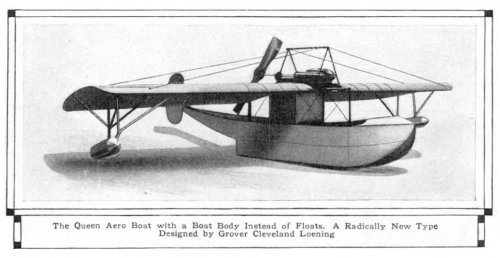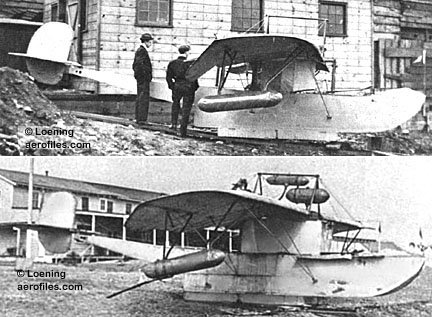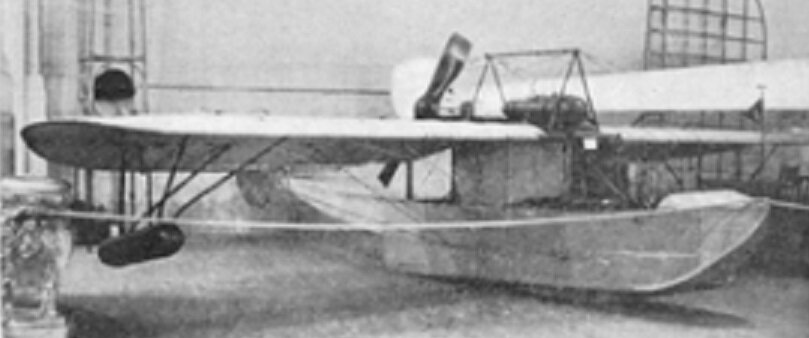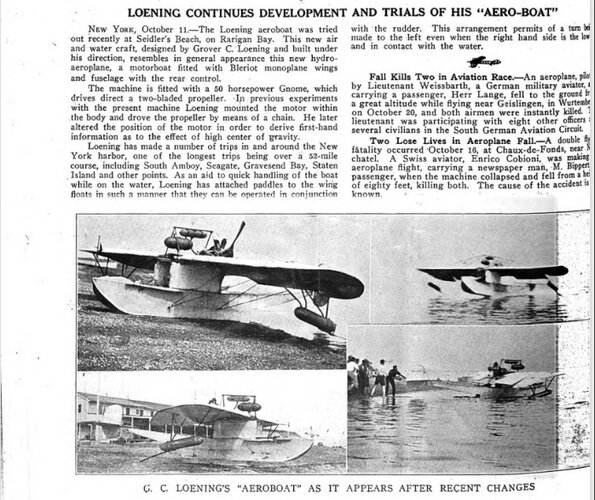- Joined
- 25 June 2009
- Messages
- 14,369
- Reaction score
- 4,974
Although he may not be well known from the general public, German-born American engineer Grover Cleveland Loening is one of the very few names in aviation that endured throughout most of the 20th century.
What is sadly forgotten though, even by aviation enthusiasts, is that he probably was the first man ever to design and fly a hull boat. Indeed, unlilke Curtiss's well-documented effort with his Flying Boat N°2, no records of the Loening trials have emerged to prove the anteriority of his success.
Already a well-known and respected author and speaker in aviation circles, Loening joined the fledgling Queen Aeroplane Company of New York City (which produced improved versions of the Bleriot monoplanes) late in 1911 to produce what he called an "aeroboat", as it resembled more a boat with aeroplanes than an aeroplane with floats attached. The design was completely unique at the time: the combination of aeroplane and boat was intended to make "aeroplaning safer and more reliable and boating more exhilarating", in the words of Queen's December 1911 press announcement. The magazine Aeronautics conjectured in its May-June issue that "essentially boat-like and machines of this order ought to appeal strongly to the motor boat bug".
The wings of the Aeroboat were standard Anzani-Bleriot surfaces, 7' chord, with sections cut out to make ailerons. A Langley-type universal tail was used, with the elevator and rudder moving about a universal joint. A steel spring counterbalanced the weight of the tail. The ailerons were operated by a foot lever. Two long levers, one for each hand, operated the elevator; pushing forward on either one steers the rudder to the respective side.
The boat portion was of aluminum sheeting, bottom and sides in one piece. Legend has it that the Aeroboat was initially concocted from an old speedboat and a Blériot fuselage. A Gibson propeller was driven by chain and sprocket from a 35 hp (and then a geared 50 hp) Gnôme engine, mounted in the hull.
Initial flight tests were made at Bayonne, New Jersey, during April 1912, with Loening himself as a pilot. Interestingly, although he was well-learnt in every theoretical aspect of aeronautics, Loening was still pretty much a novice at piloting at that stage, yet managed to take the machine in the air for a number of short flights. The control in the water was found thoroughly satisfactory, steering perfectly in and out of winds. The aircraft now needed a seasoned pilot to complete its flight testing.
The Queen Co., however, was in turmoil after the departure of its manager and chief instructor, Ladis Lewkowicz and the judicial turmoil that ensued. The Queen Aeroboat prototype was no longer heard of. Existence of a 1913 variant with improved wings cannot be verified; it has been said that it was lost in storm before it could be fully flight-tested, though it is unclear whether this was a new airframe or simply the old one reworked.
Loening went on to work for the Wilbur and Orville Wright Company. After Wilbur's untimely death, Orville needed someone to take up the burden, and as he had been impressed by the Aeroboat, he hired Loening and made him both his assistant and the manager of Wright Aircraft's Dayton, Ohio, factory. It is easy to imagine Wright's concern that Curtiss had not only caught up, but was also ahead in the field of hydroaeroplanes. Adjoining the help of a Columbia graduate who claimed the first ever U.S. master's degree in aeronautics was undoubtedly a tactical move.
And yet the collaboration was short-lived. For the Wright Co., Loening produced only the Model G Aeroboat, which was a completely different design, although it built upon the experience gained with the Queen model. He then joined Curtiss and designed their first Army tractor in 1913, but his passion was ever for hull planes, and he finally made a name of his own during the 20s and 30s for a line of very successful boat types: the Duckling, the Air Yacht, the Cabin Amphibian, the Commuter as well as a handful of scouting and observation types especially designed for the US Navy.
Specifications of 1912 Queen Aeroboat:
Main sources:
Suggested reading:
What is sadly forgotten though, even by aviation enthusiasts, is that he probably was the first man ever to design and fly a hull boat. Indeed, unlilke Curtiss's well-documented effort with his Flying Boat N°2, no records of the Loening trials have emerged to prove the anteriority of his success.
Already a well-known and respected author and speaker in aviation circles, Loening joined the fledgling Queen Aeroplane Company of New York City (which produced improved versions of the Bleriot monoplanes) late in 1911 to produce what he called an "aeroboat", as it resembled more a boat with aeroplanes than an aeroplane with floats attached. The design was completely unique at the time: the combination of aeroplane and boat was intended to make "aeroplaning safer and more reliable and boating more exhilarating", in the words of Queen's December 1911 press announcement. The magazine Aeronautics conjectured in its May-June issue that "essentially boat-like and machines of this order ought to appeal strongly to the motor boat bug".
The wings of the Aeroboat were standard Anzani-Bleriot surfaces, 7' chord, with sections cut out to make ailerons. A Langley-type universal tail was used, with the elevator and rudder moving about a universal joint. A steel spring counterbalanced the weight of the tail. The ailerons were operated by a foot lever. Two long levers, one for each hand, operated the elevator; pushing forward on either one steers the rudder to the respective side.
The boat portion was of aluminum sheeting, bottom and sides in one piece. Legend has it that the Aeroboat was initially concocted from an old speedboat and a Blériot fuselage. A Gibson propeller was driven by chain and sprocket from a 35 hp (and then a geared 50 hp) Gnôme engine, mounted in the hull.
Initial flight tests were made at Bayonne, New Jersey, during April 1912, with Loening himself as a pilot. Interestingly, although he was well-learnt in every theoretical aspect of aeronautics, Loening was still pretty much a novice at piloting at that stage, yet managed to take the machine in the air for a number of short flights. The control in the water was found thoroughly satisfactory, steering perfectly in and out of winds. The aircraft now needed a seasoned pilot to complete its flight testing.
The Queen Co., however, was in turmoil after the departure of its manager and chief instructor, Ladis Lewkowicz and the judicial turmoil that ensued. The Queen Aeroboat prototype was no longer heard of. Existence of a 1913 variant with improved wings cannot be verified; it has been said that it was lost in storm before it could be fully flight-tested, though it is unclear whether this was a new airframe or simply the old one reworked.
Loening went on to work for the Wilbur and Orville Wright Company. After Wilbur's untimely death, Orville needed someone to take up the burden, and as he had been impressed by the Aeroboat, he hired Loening and made him both his assistant and the manager of Wright Aircraft's Dayton, Ohio, factory. It is easy to imagine Wright's concern that Curtiss had not only caught up, but was also ahead in the field of hydroaeroplanes. Adjoining the help of a Columbia graduate who claimed the first ever U.S. master's degree in aeronautics was undoubtedly a tactical move.
And yet the collaboration was short-lived. For the Wright Co., Loening produced only the Model G Aeroboat, which was a completely different design, although it built upon the experience gained with the Queen model. He then joined Curtiss and designed their first Army tractor in 1913, but his passion was ever for hull planes, and he finally made a name of his own during the 20s and 30s for a line of very successful boat types: the Duckling, the Air Yacht, the Cabin Amphibian, the Commuter as well as a handful of scouting and observation types especially designed for the US Navy.
Specifications of 1912 Queen Aeroboat:
- Width: 2 ft.
- Length: 13 ft.
- Height: 2 ft.
- Wingspan: 173 sq. ft.
- Weight (unloaded): 690 lbs.
- Propeller: Gibson, 6' by 8' pitch, Worcester-type
Main sources:
- American Flying Boats and Amphibious Aircraft: an Illustrated History, by E.R. Johnson
- AERONAUTICS, 1911-1912 issues
- POPULAR MECHANICS, July 1912
Suggested reading:





